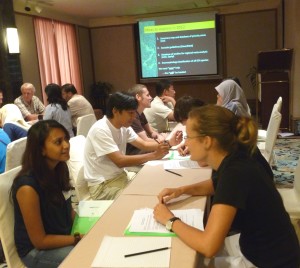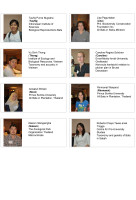Facilitators: Matt Struebig (Queen Mary University of London/DICE University of Kent, UK), Zubaid Akbar (National University of Malaysia (UKM)), David Lane (University of Brunei Darussalam), Sephy Noerfahmy (Universitas Indonesia), Juliana Senawi (Texas Tech University/UKM), Joe Chun-Chia Huang (Texas Tech University).
We tailored the forest bat workshop to address the main goals of the SEABCRU forest bats priority, and invited Southeast Asian participants who had substantial experience studying the forest bat fauna of their respective countries. The main aims/priorities addressed were:
- An appraisal of suitable survey techniques to produce methodological and ethical guidelines for their use and reporting.
- Identification of high diversity and/or research priority areas for forest bats.
- The development of a database of habitat comparison studies targeted at bats to contribute to a meta-analysis on the responses of bats to land-use change in Southeast Asia
Workshop participants: The forest bat workshop included 12 participants from seven SE Asian countries (Malaysia, Philippines, Indonesia, Vietnam, Thailand, Singapore) and Germany (Brunei). Check out the Field Guide to Forest Bat participants below.
1. Survey Techniques and ethical guidelines
Following a speed-networking exercise participants were divided into groups by region, namely Philippines, Sundaland (Indonesia, Malaysia, Brunei, Singapore and Southern Thailand) and Indochina. Participants discussed their experiences of forest bat research activities within these groups, and then shared these experiences with the rest of the group. Discussions were focused on capture techniques, namely harp traps, ground nets and canopy/stacked nets, and highlighted several models and variations of techniques that were being used within and among countries, as well as general difficulties in acquiring nets. The considerable variation in techniques and trap/net designs and configurations used highlighted the need for a common reporting and/or recommended standardized protocols to the group. A shared session with the Taxonomic group involved an introduction to acoustic methods for bat survey work. It was clear that a growing number of participants were implementing acoustic surveys, with substantial difficulty, and a common consensus was reached that there was a long way to go before these methods would be effective.
2. Priority areas for forest bat conservation and future surveys
A simple approach used at the previous bat conference to provisionally identify priority areas, whereby conference participants were surveyed, was introduced during a workshop session. Participants were presented with a database summarizing information for each Southeast Asian country on three forested areas known to support high levels of bat diversity, as well as three areas considered to be important by survey participants, but in need of bat surveys. The exercise served to illustrate large gaps in the database. It was also suggested and agreed by participants to divide some countries into biogeographic sub-regions (e.g. in Indonesia and Philippines). After some debate regarding the precise definition of priority areas, it was decided to further prioritize nominations that linked up adjacent conservation areas in neighboring countries. Participants then broke off into regional groups and undertook the exercise themselves, correcting nomination names, and delineating areas using Google Earth. We made substantial progress and participants were keen to see the results of the exercise, but it was evident that much more time was needed. We continue communications with participants independently to complete the assessment before the next workshop in 2013.
3. Meta-analysis of the effects of land-use change on Southeast Asian bats
Participants were introduced to the objective of the exercise and the concept of meta-analysis, using work from other biodiversity groups and regions as examples. The group then brainstormed parameters that they considered important to go into a database summarizing the effects of land-use change. We spent considerable time adding parameters, but then once participants started to enter data it became apparent that it needed to be simplified and develop some basic guidance! Two important concepts were highlighted by members of the group that could trouble downstream analyses:
- Caution against the use of ‘forest dependence’, as it became clear that this term was often quite subjective, and that species considered to be forest specialists in one part of the region were not necessarily considered to be specialists elsewhere. It was decided that a uniform classification as part of the taxonomic database would be useful in this regard.
- It was important to distinguish fixed ecomorphological traits (e.g. wing morphology, body size) from more ‘flexible’ traits that could change in the short term in response to disturbance (e.g. parasite load)



